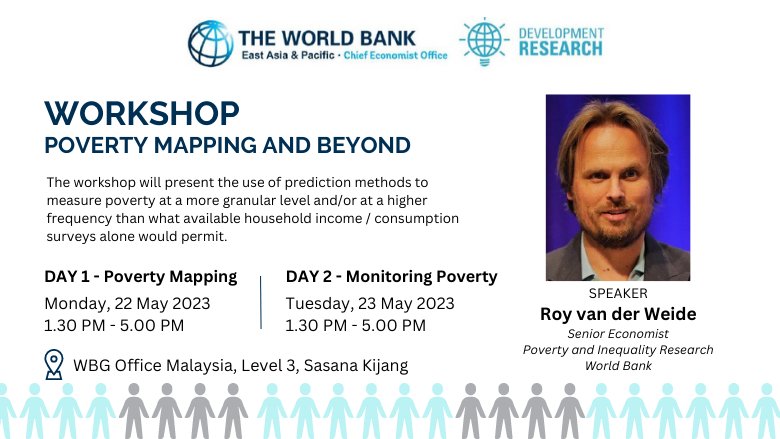The workshop will present the use of prediction methods to measure poverty at a more granular level and/or at a higher frequency than what available household income / consumption surveys alone would permit.

Day 1: POVERTY MAPPING
We begin by providing a brief review of the poverty mapping literature that dates back to early 2000s. In a nutshell, estimates of poverty at the small area level are obtained by predicting household welfare data into a population census that provides complete coverage of the country of interest. Poverty maps are found to offer an effective tool for targeting resources with the objective to alleviate poverty. Next we assesses the reliability of poverty maps derived from remote-sensing data (a popular alternative to population census data in recent years). While the two approaches reveal the same patterns in the geography of poverty, there are instances where the two approaches obtain markedly different estimates of poverty. Poverty maps obtained using remote sensing data may do well when the decision maker is interested in comparisons of poverty between assemblies of areas yet may be less reliable when the focus is on estimates for specific small areas.
Day 2: MONITORING POVERTY
It is costly to collect the household- and individual-level data that underlie official estimates of poverty (and health). For this reason, developing countries often do not have the budget to update estimates of poverty and health regularly, even though these estimates are most needed there. One way to reduce the financial burden is to substitute some of the real data with predicted data by means of double sampling, where the expensive outcome variable is collected for a subsample and its predictors for all. Recent work finds that double sampling yields only modest reductions in financial costs when imposing a statistical precision constraint in a wide range of realistic empirical settings. There are circumstances in which the gains can be more substantial, but these denote the exception rather than the rule. The recommendation is to rely on real data whenever there is a need for new data and to use prediction estimators to leverage existing data.
Day 1: MAY 22, 2023
1:30-3:00PM – Poverty Mapping Part 1
3:00-3:30PM - Coffee Break
3:30-5:00PM – Poverty Mapping Part 2
Day 2: MAY 23, 2023
1:30-3:00PM – Monitoring Poverty Part 1
3:00-3:30PM - Coffee Break
3:30-5:00PM – Monitoring Poverty Part 2
